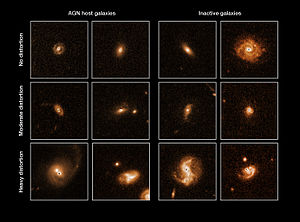- Cosmic Evolution Survey
-
The Cosmic Evolution Survey (COSMOS) is a Hubble Space Telescope (HST) Treasury Project to survey a two square degree equatorial field with the Advanced Camera for Surveys (ACS). The largest survey ever undertaken by HST, the project incorporates commitments from observatories around the world, such as the Very Large Array radio observatory, the European Space Agency's XMM-Newton satellite, and Japan's eight meter Subaru telescope. At the moment, more 150 astronomers around the world actively contribute to the project.
The project's primary goal is to study the relationship between large scale structure (LSS) in the universe and dark matter, the formation of galaxies, and nuclear activity in galaxies. This includes careful analysis of the dependence of galaxy evolution on environment[1] . The survey covers 2 square degrees of sky in the constellation Sextans.
Gallery
-
COSMOS survey combines data from ESO’s Very Large Telescope and ESA’s XMM-Newton X-ray space observatory[2].
References
- ^ "COSMOS". Cosmic Evolution Survey. http://cosmos.astro.caltech.edu/overview/index.html. Retrieved 13 July 2011.
- ^ "What Activates a Supermassive Black Hole?". ESO Science Release. ESO. http://www.eso.org/public/news/eso1124/. Retrieved 13 July 2011.
Categories:- Hubble Space Telescope
- Astronomy stubs
-
Wikimedia Foundation. 2010.


